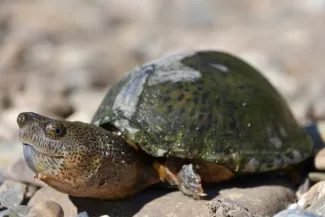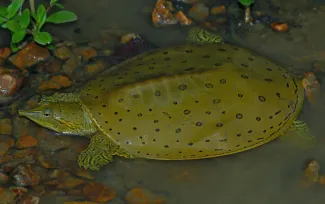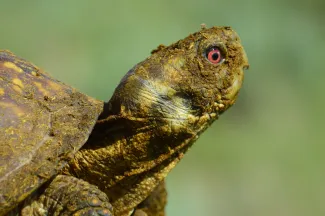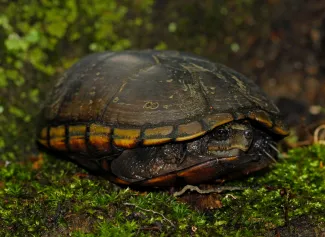From sliders and snappers to softshells, Oklahoma has a strong representation of turtles. In fact, more than 30% of the species native to the U.S. can be found in our state! Turtles – both land and aquatic – can be found across Oklahoma and provide a variety of ecosystem services.
Settle in for five quick “turtorials” on Oklahoma’s shell-stopping turtles.
Oklahoma has EIGHTEEN species of turtles.

📷 Razor-backed musk turtle
Oklahoma’s turtle species can be broken into four broad groups: snapping turtles, mud and musk turtles, pond and box turtles, and softshell turtles. With the exception of the two species of land-dwelling box turtles (which are still turtles, not tortoises), all of Oklahoma’s turtles are tied to water. Body temperatures are largely influenced by the air temperature, so many of these water turtles bask on logs or on the bank to warm and be better able to respond to predators or digest food. To survive the winter, turtles may burrow underground or go dormant at the bottom of their stream or river.
Contrary to popular belief, turtles are not universally detrimental to our state’s diverse fishery. While some species, like snapping turtles, are carnivorous, most predatory turtles are opportunistic scavengers and feed largely on dead fish. Adult red-eared sliders join several other turtle species in a more herbivorous diet, primarily eating aquatic plants. Still other turtles, like Mississippi map turtles, eat a variety of snails and freshwater mussels.
Three species, the common snapping turtle, red-eared slider, and spiny softshell can be found statewide.
Bonus habitat trivia: Many water turtles love to soak in the sunshine. Providing brush, wood, or rock piles can be a good way to increase basking and cover habitat for turtles and other reptiles, especially around water features or ponds. Get more tips for attracting reptiles and amphibians from our online Landscaping for Wildlife guide.
Oklahoma’s turtles have hard and soft shells.

📷 Spiny softshell
For many, a turtle’s shell is a defining feature of turtle-hood. And in many ways, it should be. The ribs and vertebrae are part of the top shell, or carapace, so a turtle literally cannot come out of its shell. But not all turtles have the classic turtle shell with large scales, or scutes. Two species of softshell turtles can be found in Oklahoma and have soft and flexible leathery shells.
How to tell the softshell turtles apart? While the spiny softshell does have small, blunt spines on the edge of the shell, it is best distinguished from the state’s other softshell turtle, the midland smooth softshell, by a close inspection of the snout. Spiny softshells have small projections on the inside of the nostrils.
Though a great protective feature for some, not all turtles can fully retreat into their shells. Both snapping turtles – common and alligator – have disproportionately small bottom shells, or plastrons, and cannot physically withdraw into their shell. Box turtles, on the other hand, have a hinged plastron (mud turtles have hinges on the front and back portions of the plastron) and can fully enclose their bodies within their shells.
Turtle nests must be on land.
After mating, females dig nests with their back feet, deposit their leathery eggs, and leave their offspring’s fate to nature. Nests must be made on land as the eggshells are permeable and the embryos would drown if eggs were laid in water.
In general, multiple egg clutches may be produced from May through mid-July. Three-toed box turtles can even store sperm for up to four years and have been known to produce fertilized eggs years after mating.
Bonus Turtle Trivia: Adult turtles don’t have teeth, but hatchlings have a keratinous egg tooth, or caruncle, on their beak tip that helps them break through the egg during hatching. The “tooth” is often lost after a few days.
The red eye.

📷 Plains box turtle
Size can often be used to determine male turtles from females – females are traditionally larger in size – but other cues are visible in some species. Male box turtles have red eyes while females have yellow or brown eyes. And many male water turtles have long front claws they use in courtship displays. Males of many species also have longer and thicker tales than their female counterparts.
For many turtles, gender is largely determined by incubation temperature. Depending on the species, two patterns emerge. In some, low incubation temperatures only produce males while high temperatures only produce females. In other turtles, both high and low incubation temperatures generate mostly females while intermediate temperatures generate mostly males. In Oklahoma, turtle gender is only determined by sex chromosomes in softshell turtles.
Long live turtles.

📷 Mississippi mud turtle
In general, Oklahoma’s turtles are long-lived and slow to reach maturity. Red-eared sliders can live up to 25 years in natural environments and box turtles have been reported to live longer than 50 years! A male alligator snapping turtle at the Philadelphia Zoo was thought to live 80 years.
Learn more about Oklahoma's turtles in the Wildlife Department's "A Field Guide to Oklahoma's Amphibians and Reptiles." Tips for identification, a map of the Oklahoma range, and information about the diet and preferred habitats are provided for 135 species of herpetofauna that can be found in the state. The book’s spiral binding makes it easy to flip through and make comparisons of different species when identifying animals at home or in the field. Copies are available at GoOutdoorsOklahoma.com.
